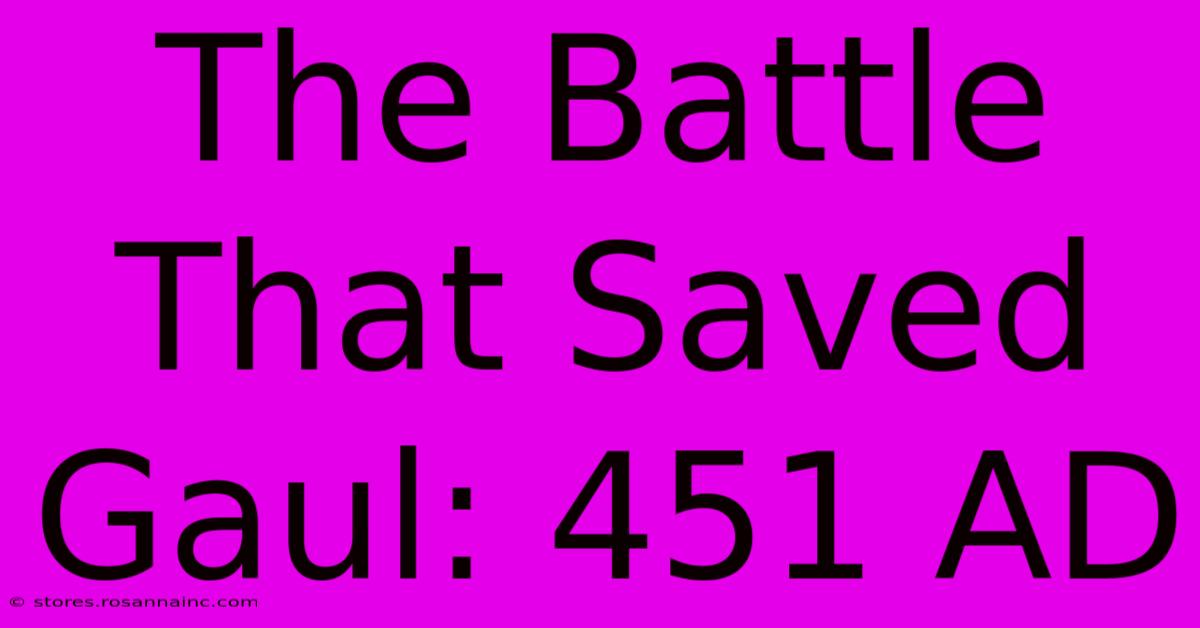The Battle That Saved Gaul: 451 AD

Table of Contents
The Battle That Saved Gaul: A Deep Dive into the Catalaunian Plains Clash of 451 AD
The year is 451 AD. The Roman Empire, once the undisputed master of the Mediterranean world, is crumbling. Across the Rhine, a terrifying force gathers: Attila the Hun and his fearsome horde. Their sights are set on Gaul (modern-day France), and the fate of Western Europe hangs precariously in the balance. This article delves into the Battle of the Catalaunian Plains, a pivotal clash that arguably saved Gaul from Hunnic conquest and reshaped the course of history.
The Shadow of Attila: The Hunnic Advance
Attila the Hun, often portrayed as the "Scourge of God," led a vast and highly mobile army composed of diverse tribes, including Huns, Ostrogoths, Gepids, and Alans. His military tactics were renowned for their brutality and effectiveness. He employed a devastating combination of cavalry charges and archery, exploiting weaknesses in enemy formations with ruthless efficiency. His conquests spread terror throughout Europe, leaving a trail of destruction in his wake.
By 451 AD, Attila's ambitions were focused on Gaul. The fertile lands and strategic importance of the region made it a highly desirable prize. His invasion posed an existential threat to the weakened Western Roman Empire and the various Germanic tribes inhabiting Gaul.
The Gathering Storm: Alliances and Preparations
Faced with imminent annihilation, the Romans, under the command of Flavius Aetius, a skilled general known for his pragmatism, were forced into an uneasy alliance with their traditional enemies, the Visigoths. This unusual partnership highlights the gravity of the situation. The Visigoths, led by their King Theodoric I, were a powerful force in their own right, but internal rivalries and disagreements with the Romans had been long-standing.
Despite their differences, the shared threat of Hunnic conquest compelled them to unite against Attila. The alliance, though fragile, proved crucial in the upcoming battle. This collaboration highlights the complex political landscape of 5th-century Europe, demonstrating how the immediate threat transcended long-standing conflicts.
The Battle of the Catalaunian Plains: A Clash of Titans
The exact location of the Battle of the Catalaunian Plains remains a subject of historical debate, although most scholars place it somewhere near Châlons-en-Champagne in modern-day France. The battle itself was a brutal and bloody affair, lasting a full day.
The Tactics and the Struggle: A Day of Bloodshed
The battle unfolded in several stages. Attila, deploying his characteristic cavalry tactics, launched a series of devastating attacks. The Visigoths, positioned on the Roman right flank, bore the brunt of the initial assaults. The battle was fiercely contested; sources mention a chaotic melee with heavy losses on both sides.
A crucial turning point occurred when Theodoric I, the Visigoth king, was killed. His death threatened to shatter the alliance and demoralize the Visigoth army. However, Aetius and his Roman forces held their ground, preventing the Hunnic advance from exploiting this critical moment of vulnerability.
The battle raged on until the evening, ending in a tactical victory for the allied Roman and Visigoth forces. While neither side could claim a clear-cut victory, Attila's advance was decisively halted. The Hunnic army, suffering significant losses, was forced to retreat. This prevented the complete subjugation of Gaul, and is widely considered a crucial turning point.
The Aftermath: Legacy of a Hard-Fought Battle
The Battle of the Catalaunian Plains did not end the Hunnic threat completely. Attila continued his raids and conquests for several years. However, the battle significantly weakened his power, and importantly, prevented the complete devastation of Gaul. It proved to be a turning point in the history of the Roman Empire and all of Europe.
A Turning Point in History
The battle's impact is profound. It is often credited with saving Western Roman civilization in Gaul, preventing the Hunnic conquest which would have reshaped the political and cultural landscape of the region. This hard-won victory also underscored the importance of strategic alliances against a formidable common enemy.
The legacy of this brutal clash resonates to this day, a testament to the courage and tenacity of the combatants on both sides. It exemplifies a defining moment in the fall of the Western Roman Empire, demonstrating how strategic alliances, despite their inherent fragility, could often shape the outcome of major historical conflicts. The Battle of the Catalaunian Plains serves as a powerful reminder of the fragility of civilizations and the vital role that strategic decisions and military prowess play in shaping the course of history.

Thank you for visiting our website wich cover about The Battle That Saved Gaul: 451 AD. We hope the information provided has been useful to you. Feel free to contact us if you have any questions or need further assistance. See you next time and dont miss to bookmark.
Featured Posts
-
Single Moms Club Cast Shares Their Parenting Hacks
Feb 09, 2025
-
Nels Van Patten Wiki Discover His Untold Story
Feb 09, 2025
-
Birmingham Vs Newcastle Fa Cup Live
Feb 09, 2025
-
January 28 Zodiac Embrace Your Strengths Conquer Your Weaknesses
Feb 09, 2025
-
Castilla La Manchas Caja Beyond Banking Building Community
Feb 09, 2025
